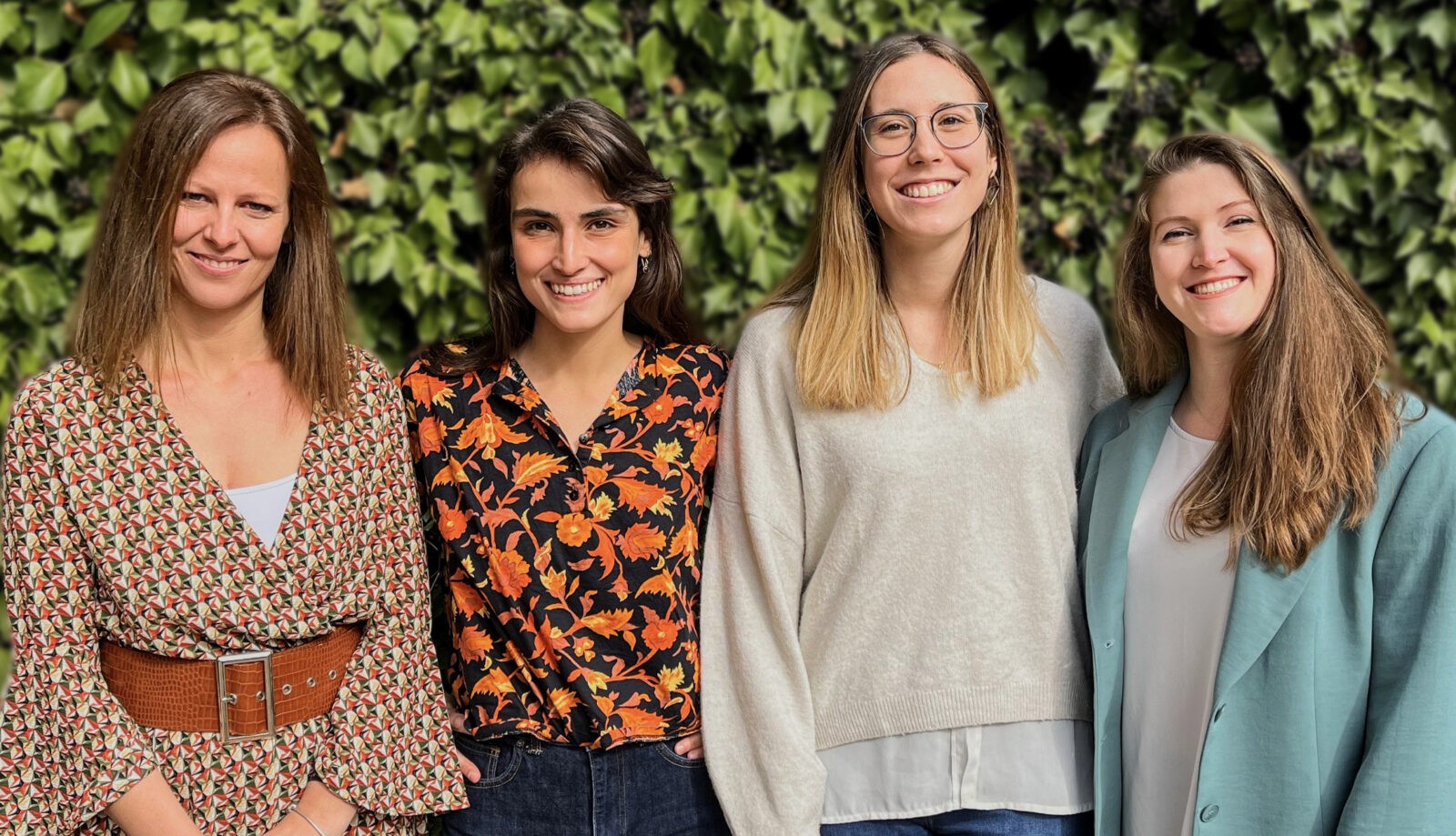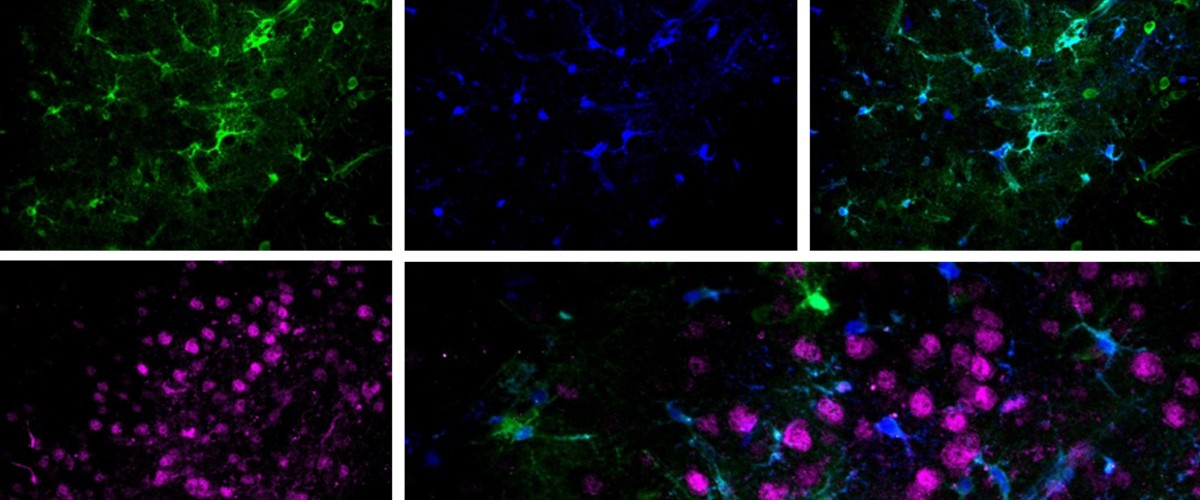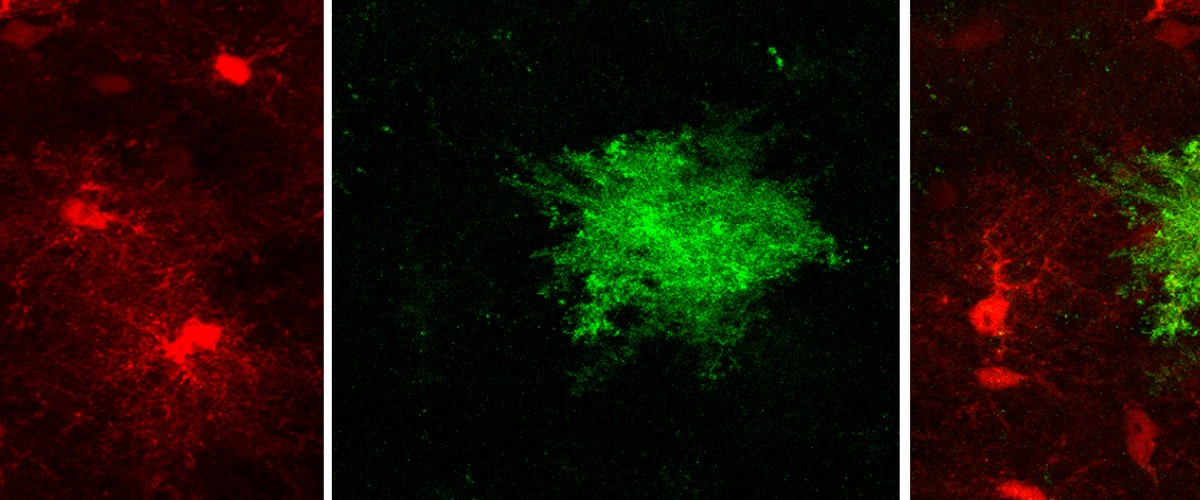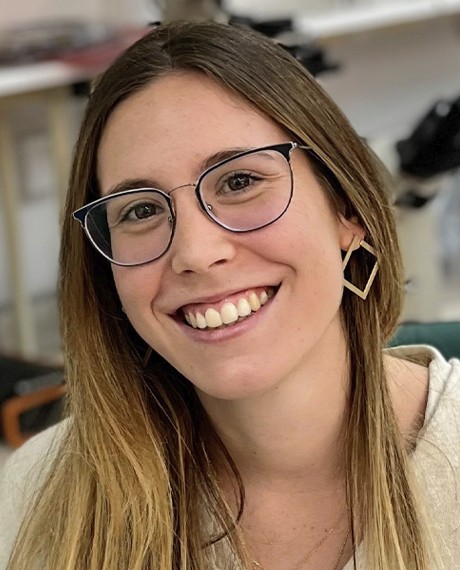LABORATORIES
Synaptic plasticity and astrocyte-neuron interactions
Synaptic plasticity and astrocyte-neuron interactions
Research
Team
Publications
Contact
Others
Research
The brains of evolutionarily superior mammals are endowed with information-processing capabilities that enable them to perform tasks of planning, decision-making, learning, and memory. Although these highly developed brain functions are usually attributed exclusively to neuronal function, recent studies point to an important role for glia, especially astrocytes, in behaviour, cognitive functions and brain pathologies. How astrocytes exercise this control is the main question that the Laboratory of Synaptic Plasticity and Astrocytic-Neuronal Interactions focuses on.

Our current research focuses on the study of the role of astrocytes in the modulation of synaptic function and the neural network, with the aim of understanding their role in the physiological and pathological aspects of brain function. More concretely,
We develop tools that allow us to manipulate the diversity of astrocytes. Neuron-astrocyte networks display a surprising degree of complexity, and state-of-the-art complementary tools are required to understand the involvement of astrocytes in modulating circuitry and behavior. Although the evolution of genetic tools to study and control these circuits has focused primarily on neuronal activity, the Synaptic Plasticity and Astrocytic-Neuronal Interactions Laboratory has focused on developing techniques to specifically dissect active astrocytic circuits with precision space. -temporary.
To determine the role of astroglial networks in the control of network activity and related executive functions in the Nucleus Accumbens. Due to the difficulty of inducing manipulation of specific astrocytes in vivo, only a handful of studies have directly investigated the involvement of particular sets of astrocytes in specific behavior.
While the neural mechanisms underlying synaptic plasticity have been widely identified, the involvement of astrocytes in these processes has been less recognized. We are addressing the participation of astrocytes in learning and memory from different aspects, studying 1.- whether astrocytes are capable of independently encoding some memory characteristics and 2.- whether gliotransmission affects the strength of connectivity between brain regions.
Unraveling how astrocytes control the activity of neural circuits is essential, not only to achieve a comprehensive dissection of brain information processing, but also to provide a novel framework to identify alternative therapeutic targets.
Equipment
In vitro electrophysiology.
Electrophysiology in vivo.
Fiber optic image.
dynamic calcium imaging
Optogenetics.
chemogenetics.
Histology.
Transgenic mice.






Team

Marta Navarrete
Principal investigator

Irene Serra
Predoctoral student

Javier Sánchez
Predoctoral student

Cristina Martín
Predoctoral student
Javier Sáchez-Romero (Pre doctoral student): Fundación Tatiana fellowship- “AstrocytesDecodificación del diálogo Astrocito-Neurona en el Núcleo Accumbens” Defense expected, 2026.
Laura Delgado (Pre doctoral student): CAM fellowship -PEJ-2020-AI/BMD-18245- “Probing Astrocytic Integration in the Accumbens-Pallidal circuits that supports cognitive processing”. Defense expected 2024. This project will allow the laboratory to get immersed in areas of knowledge so far unexplored, such as the analysis of signals, and the set-up and fine-tuning of newly purchased equipment involved in in-vivo signals acquisition. See Linkedin (linkedin.com/in/laura-delgado-02a902173) and ORCID (https://orcid.org/0000-0002-1361-4234).
Cristina Martín-Monteagudo (Pre doctoral student): FPU fellowship -FPU19/001667- “Astrocytes control the cognitive impairment derived from chronic exposure to THC” Defense expected, 2024.
Irene Serra Hueto (Pre doctoral student): “Astrocyte heterogeneity in the Nucleus Accumbens” Defense expected, 2023. This project studies the functional heterogeneity of Nucleus Accumbens astrocytes by a multidisciplinary approach based on implementing new molecular tools for astrocytes which allow the characterization and modulation of specific neuron-astrocytes circuits within the nucleus.
Publications
Featured publications
- Serra I, Quintanilla J, García Marqués J, Navarrete M. (2023) Catching Astrocyte Ensembles: Astrocytic Ensembles Control. Research Square doi:10.21203/rs.3.rs-3427853/v1
- Justin L, Baraibar A, Nanclares C, Martín ED, Aguilar J, Kofuji P, Navarrete M, Araque A. (2023) A spatial threshold for astrocyte calcium surge. eLife doi:10.7554/eLife.90046.1
- Delgado L & Navarrete M. (2022) Shining the Light on Astrocytic Ensembles. Cells doi: 10.3390/cells12091253
- Serra I, Esparza J, Delgado L, Martin-Monteagudo C, Puigròs M, Podlesniy P, Trullas R, Navarrete M. (2022) Ca2+-modulated Photoactivatable Imaging Reveals Neuron-Astrocyte Glutamatergic Circuitries within the Nucleus Accumbens. Nature Communications doi: 10.1038/s41467-022-33020-6
- Fernandez JM, Martinez-Rachadell L, Navarrete M, Palenzuela R, Ruiz de Martin Esteban S, Mostany R, Davila JC, Garcia-Caceres C, Tschöp M, Gutierrez A, Torres-Alemán I. (2022) Insulin regulates neuro-vascular coupling through astrocytes. PNAS doi:10.1101/720813
- Durkee C, Kofuji P, Navarrete M&´, Araque A&´. 2021 Astrocyte and neuron cooperation in long-term depression. Trends in Neurosci. doi: 10.1016/j.tins.2021.07.004 (&´ Corresponding authors)
- Navarro-Gonzalez C, Carceller H, Benito M, Serra I, Navarrete M, Rodríguez-Prieto A, González-Manteiga A, Fazzari P. 2021. Nrg1 haploinsufficiency alters the inhibitory homeostasis of cortical circuits. Neurobiol. Dis. doi: 10.1016/j.nbd.2021.105442
- Rosa JM, Farre-Alins V, Ortega MC, Navarrete M, Lopez-Rodriguez AB, Palomino-Antolin A, Fernandez-Lopez E, Vila-del Sol V, Decouty C, Narros-Fernandez P, Clemente D, Egea J.. 2021 TLR4-pathway impairs synaptic number and cerebrovascular functions through astrocyte activation following traumatic brain injury. British J. of Pharmacology. doi: 10.1101/2020.03.01.972158
- Domingo-Rodriguez L, Ruiz de Azua I, Dominguez E, Senabre E, Serra I, Kummer S, Navandar M, Baddenhausen S, Hofmann C, Andero R, Gerber S, Navarrete M, Dierssen M, Lutz B, Martín-García E, Maldonado R. 2020 A specific prelimbic-nucleus accumbens pathway controls resilience versus vulnerability to develop food addiction. Nature Communications. 11, 782
- Navarrete M&´, Cuartero MI, Palenzuela R, Draffin J, Konomi A, Serra I, Colié S, Castaño-Castaño S, Hasan MT, Nebreda AR, Esteban JA&´. 2019 Astrocytic p38α MAPK drives NMDA receptor-dependent long-term depression and modulates long-term memory. Nature Communications. 10:2968 (&´ Corresponding authors.). Recommended in: F1000Prime
- Sánchez-Puelles C, Arroyo A, Diez I, Erramuzpe A, Jimenez-Marin, A, Cortés J, Martínez-Hernández J, Luján R, Navarrete M, Andrew A, Venero C, Morales M, Esteban JA, Knafo S. 2019 PTEN controls synaptic performance in the cortico-amygdala circuit, influencing social behaviour in autism with macrocephaly. Cerebral Cortex. 30:505-524.
- Mederos S*, Hernández-Vivanco A*, Ramírez-Franco J, Martín-Fernández M, Navarrete M, Yang A, Boyden ES, Perea G. 2019 Melanopsin for precise optogenetic activation of astrocyte-neuron networks. Glia. doi: 10.1002/glia.23580.
- Briz CG, Navarrete M, Esteban JA, Nieto M. 2017 In utero electroporation approaches to study the excitability of neuronal subpopulations and single-cell connectivity. JOVE Science Education Database. Issue 120; doi: 10.3791/55139.
- Pallas-Bazarra N, Jurado-Arjona J, Navarrete M, Esteban JA, Hernández F, Ávila J, Llorens-Martín M. 2016 Novel function of Tau in regulating the effects of external stimuli on adult hippocampal neurogenesis. EMBO J, pii: e201593518.
- Rodríguez-Tornos FM, Briz CG, Weiss LA, Sebastián-Serrano A, Ares S, Navarrete M, Galazo M, Frangeu L, Jabaudon D, Esteban JA, Nieto M. 2016 Cux1 enables inter-hemispheric connections of layer II-III neurons by regulating 1 Kv1-dependent firing. Neuron, 89:494-506.
- Gómez-Gonzalo M*, Navarrete M*, Perea G*, Covelo A*, Martín-Fernández M, Shigemoto R, Luján R, Araque A. 2015 Endocannabinoids induce lateral long-term potentiation of transmitter release by stimulation of gliotransmission. Cereb Cortex, pii: bhu231. (* Equal contribution.)
- Perez-Alvarez A*, Navarrete M*, Covelo A, Martín ED, Araque A. 2014 Structural and functional plasticity of astrocyte process and dendritic spine interactions. J Neurosci, 34:12738 –12744. (* Equal contribution.)
- Navarrete M, Díez A, Araque A. 2014. Astrocytes in endocannabinoid signaling. Phil. Trans. R. Soc. Lond. B, 369:20130599.
- Navarrete M, Araque A. 2014. The Cajal school and the physiological role of astrocytes: away of thinking. Frontiers in Neuroanatomy, 8:33.
- Navarrete M, Perea G, Maglio L, Pastor J, García de Sola R, Araque A. 2013 Astrocyte Calcium Signal and Gliotransmission in Human Brain Tissue. Cereb Cortex, 23:1240-1246.
- Navarrete M, Perea G, Fernandez de Sevilla D, Gómez-Gonzalo M, Núñez A, Martín ED and Araque A. 2012 Astrocytes mediate in vivo cholinergic-induced synaptic plasticity. PLoS Biology, 10:e1001259. (Research highlights in: Nat Rev Neurosci, 2012 13:221-221, Comment in: PLoS Biol. 2012 10:e1001263.)
- Araque A and Navarrete M. 2011 Electrically driven insulation in the central nervous system. Science, 333:1587-1588.
- Navarrete M and Araque. A. 2011 Basal Synaptic Transmission: Astrocytes Rule! Cell, 146:675-677
- Porto-Pazos AB, Veiguela N, Mesejo P, Navarrete M, Alvarellos A, Ibáñez O, Munteanu CR, Pazos A and Araque A. 2011 Artificial astrocytes improve neural network performance. PLoS ONE, 6:e19109.
- Navarrete M and Araque A. 2010 Endocannabinoids potentiate hippocampal synaptic transmission through stimulation of astrocytes. Neuron, 68:113-126. (Comment in: Nat Rev Neurosci. 2010 11:788-788.)
- Araque A and Navarrete M. 2010 Glial cells in neuronal network function. Phil. Trans. R. Soc. Lond. B., 365:2375-2381.
- Perea G, Navarrete M and Araque A. 2009 Tripartite synapses: Astrocytes process and control synaptic information. Trends in Neurosci. 32, 421-431. IF: 14. cit: 1453
- Navarrete M and Araque A. 2008 Endocannabinoids mediate neuron-astrocyte Communication. Neuron, 57:883-893.
- Rangel C, Navarrete M, Corchado JC, Espinosa-García J. 2006 Potential energy surface, kinetics, and dynamics study of the Cl + CH4 → HCl + CH3 reaction. J Chem Phys, 124:124306.
- Navarrete M, Rangel C, Corchado JC and Espinosa-García J. 2005 Trapping of the OH radical by α-Tocopherol. A theoretical study. J Phys Chem A, 109:4777-4784.
- Navarrete M, Rangel C, Espinosa-García J and Corchado JC. 2005 Theoretical Study of the Antioxidant Activity of Vitamin E. Reactions of α-Tocopherol with the Hydroperoxy Radical. J Chem Theory Comput, 1:337-344.
- Rangel C, Navarrete M and Espinosa-García J. 2005 Potential energy surface for the F(2P3/2, 2P1/2) + CH4 hydrogen abstraction reaction. Kinetics and dynamics study. J Phys Chem A, 109:1441-1448.
- Espinosa-García J, Rangel C, Navarrete M and Corchado JC. 2004 New hybrid method for reactive systems from integrating molecular orbital or molecular mechanics methods with analytical energy surfaces. J Chem Phys, 121:5098-5108.
- Rangel C, Navarrete M, Corchado JC and Espinosa-García J. 2004 Mechanism and Kinetics of the n-propyl bromide and OH reaction using integrated ab initio methods and variational transition-state theory. J Mol Struct-Theochem, 679:207-224.
Other publications:
Araque A, Navarrete M (2013) El ayer y hoy de los astrocitos. Mente y Cerebro 60: 86-91.
Contact
Where to find us
Laboratory of Synaptic Plasticity and Astrocyte-Neuron Interactions
Laboratory A-20-21. Instituto Cajal CSIC
Instituto Cajal CSIC. Avda. Doctor Arce, 37. 28002. Madrid
Call us
Phone number:
Write us
Email address:
Others
Granted projects
2022-24: Ministry of Science and Innovation. Spain. PID2021-122586NB-I00 “Decoding the neuron-astrocyte dialogue at Nucleus Accumbens and its impact in cognitive processing.” (Astro-Light)” Total amount: 205 700 €. Duration: 01/09/2022-31/08/2025.
2022: ISN Career Development Grant. International Society for Neurochemistry. Total amount: 10 000$ Duration: 01/02/2022-30/01/2023.
2022: Intramural CSIC. 2021AEP093. 18 500 €. Duration: 01/06/2022-30/08/2022.
2020-2022 : Universidad Francisco de Vitoria. UFV_2020. I. P.: Dr. R. Palenzuela.
2019-21: Ministry of Science, Innovation and Universities. Spain. RTI2018-094887-B-I00 “The tripartite synapse in the Nucleus Accumbens: Implications in addiction” Total amount: 198 600 €. Duration: 01/01/2019-31/12/2021.
2018: Intramural CSIC. 40 000 €. Duration: 01/06/2018-31/05/2023.
2018-23: Ministry of Economy and Competitiveness. Spain RYC-2016-20414. Total amount: 208 600 €. Duration: 01/06/2018-31/05/2023.
2015-18: Ministry of Economy and Competitiveness. Spain. SAF2014-58598-JIN. “Alteration in the bidirectional communication between astrocytes and neurons in Alzheimer’s disease”. Total amount: 203 280 €. Duration: 01/10/2015-31/09/2018.
2016: L´Oreal-Unesco “for woman in Science”. Spain. “Contribución Astrocitaria a la plasticidad sináptica”. Total amount: 15 000 €. Duration: 01/01/2016-31/12/2016.
2014-15: BBVA Foundation, Spain. “I Convocatoria Ayudas Fundación BBVA a Investigadores, Innovadores y Creadores Culturales” “Alteración en la comunicación bidireccional entre Astrocitos y Neuronas en la enfermedad de Alzheimer”. Total amount: 40 000 €. Duration: 01/12/2014 – 30/11/2015.
Thesis
- Characterization of Astro-Light for the study of astrocytic subpopulations in the Nucleus Accumbens
Andrea Rojas Martínez (2022)
Universidad Francisco de Vitoria
Trabajo fin de Grado - The tripartite synapse in the nucleus accumbens: implications in addiction
Cristina Martín Monteagudo (2019)
Trabajo fin de Máster - Images and electrophysiology signals processing based on MATLAB
Julio Esparza (2018)
Internship Student - Images and electrophysiology signals processing based on MATLAB
Julio Esparza (2018)
Internship Student - Role of glia in adiction processes
Irene Serra (2018)
Universidad Autónoma de Madrid
Beca de la UAM. Estudiante de doctorado - Astrocityc P38alpha MAPK and synaptic plasticity
Ainoa Konomi Pilkati (2017)
University of Copenhagen
Trabajo fin de Grado - Astrocyte Roles in Long Term Depression
Arantzazu San Agustín Pérez (2017)
Universidad Autónoma de Madrid
Trabajo fin de Máster
International mobility programs
- Erasmus Program
Marcyn Wyroslak
Summer student, University of Gdansk, Poland (2018) - OléSAY Program
Martina Worden
Summer student, Puget Sound University, EEUU (2018)
Scientific dissemination
- ‘OndaCampus’. Radiotelevisión de la Universidad de Extremadura
06/05/2016. Tu futuro empieza en la UEX - ‘Millennium’. RTVE
24/10/2016. Curiosidad, ¿natural o cultural? - ‘El Lince 3.0’. Canal Extremadura
31/05/2017. Un viaje alucinante - ‘Innovamos’. Canal Extremadura
12/12/2021. Conectad@s con… Marta Navarrete - ABC
31/07/2015. Entrevista. Marta Navarrete:
«En el aprendizaje, los astrocitos son tan importantes como las neuronas» - EL MUNDO
24/09/2015. ‘Cambia las cifras’: un manifiesto para dar visibilidad a las mujeres científicas - PÚBLICO
27/03/2008. Estudio revela que astrocitos del cerebro están implicados en la fisiología de la adicción de drogas - 20 MINUTOS
23/09/2015. Las investigadoras piden más peso femenino en ciencia: “Es un mundo dominado por hombres” - EL CONFIDENCIAL
30/07/2015. La Sociedad Española de Neurociencia otorga su premio a jóvenes científicos - HOY
05/09/2016. Una exploradora del cerebro - HOY
04/08/2015. Entrevista. Marta Navarrete:
«Quiero que mis investigaciones cambien los libros de texto» - EL PERIÓDICO EXTREMADURA
21/09/2015. Entrevista. Marta Navarrete:
«Los investigadores tenemos numerosos proyectos, pero faltan medios y financiación» - LEVANTE-EMV. Tendencias 21
08/07/2020. La SENC premia a la investigadora Marta Navarrete por su trabajo sobre la función nerviosa de los astrocitos - INFORMACIÓN
27/03/2008. Los astrocitos están implicados en la fisiología de la adicción de drogas - CUÍDATE PLUS
23/02/2015. Los astrocitos expresan receptores funcionales de los cannabinoides tipo 1 - EL CONFIDENCIAL
24/02/2015. La formación de la memoria genera cambios en los astrocitos - FARO DE VIGO
26/03/2008. Los astrocitos están implicados en la fisiología de la adicción de drogas - ELLE
Mujeres ELLE. Fuera de serie. ELLE convoca a diez de las científicas más brillantes de España para radiografiar el presente del I+D - EL PAÍS SEMANAL
27/11/2015. A la vanguardia de la ciencia - MI CIENTÍFICA FAVORITA
12/09/2017. Marta Navarrete Llinás

Neuroscience Research Center dependent on the CSIC. Founded in 1920 and initially directed by Santiago Ramón y Cajal. World reference in the study of the brain. Custodian of the Cajal Legacy.
Activities
